11.0 miles 5h 14m ascent 79m

Workington – (just past) Maryport
Rain was forecast so I couldn’t say the day’s weather was unexpected, but early morning sunshine had tempted me into hoping otherwise. We began where the last leg left off at the Railway station in Workington. The ox-eye daisies by the car park were still splendid. Indeed as we set off my hopes for the weather were undashed.
I had thought the route would take us along the busy main road and across the Derwent on the A597’s bridge, but just as we reached the old industrial building, a sign indicated the English Coastal Route (ECR) headed left across an old bridge, and we obediently followed its advice. This brought us onto a rough area, perhaps a car park, beside the Derwent park, a rugby ground. There seemed no path between the stadium and the railway. The only way forward was into the stadium grounds, which seemed an unlikely route for a walking route. There was a footbridge crossing the railway to our left, and with no other choices we presumed that must be our way.

Over the bridge was a path leading off towards the headland but also a way trodden through the long grass. This looked to be heading towards the river so we followed it. The grass, however, grew less trampled and the way more overgrown as we walked on. Christy had to leap through long grass rather than walking a trodden route and my trousers became heavy with water from the wet grass. At the river bank we found the railway viaduct blocking our way upstream. This obviously wasn’t the way. About turn.
As we picked our way back and over the footbridge the very light rain was becoming, if not heavy, then certainly less light. Rainwear was required. I decided to try the rain cape, which in covered both myself and my rucksack. So it was that passers-by might have noticed a Quasimodo silhouette beside the A597 cursing a misleading sign .

Once back in my stride I heard “Mike!” but being in a strange town, where it was unlikely someone would be calling to me, I paid no heed. But the call was repeated so Orpheus-like I stopped and turned. Eurydice had lost her watch. We were compelled to return whence we had come. Luckily the watch was near the footbridge so we were spared searching in the long grass.
Eventually on track we followed the main road, ignored signs for Hadrian’s cycleway off the the right, and crossed the Derwent, taking a moment to look both up and downstream. It wasn’t quite as dull as the photographs suggest. There is a roundabout beyond the river with an anchor mounted on it. The first of many anchors we would see during the day.
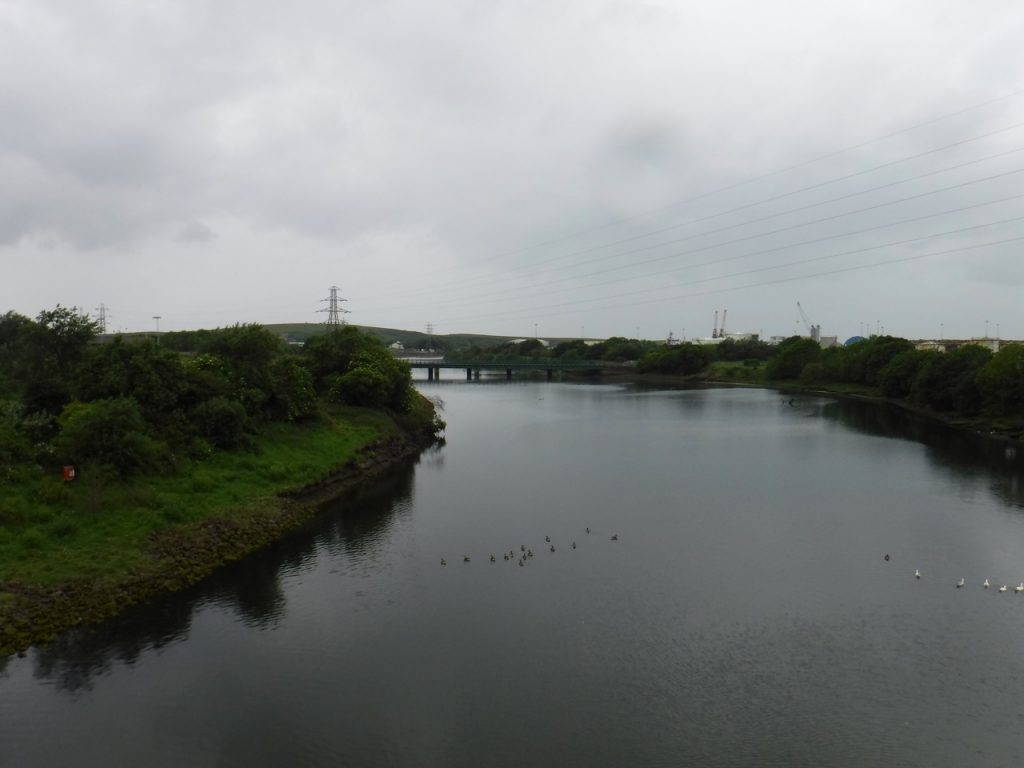
We escaped the main road for the much quieter Dock Road walking past relatively new industrial buildings. The OS map has the ECR continuing further on this road and then along the coast through a wind farm. But just before the railway was a sign for the Coastal path. A notice explained that the coastal path had been diverted because of coastal erosion. The alternative, a cycleway beside the railway, didn’t seem too bad. The dog could run free, inviting us to play by leaving sticks in our path. The turbines we would have walked beneath were visible over dense growths of wild roses whose scent filled the air. There had been fire in some sections leaving a legacy of burnt shrubbery. I found it strange how one shrub was completely burnt and that beside it apparently untouched. {Edit: I now understand why]

After meandering along, the path brought us to a main road (A596) but on a path separated from the road by a line of tall shrubs.
Here we went a wee bit astray. I had noticed a signpost for the English Coastal Path. The indicated path, beside Wythegill Syke, drew my attention immediately, looking very inviting compared to the main road. So I did not see that cycleway continued beside the road until driving back a few hours later. The signpost was rather old which should perhaps have made me wary but such diversions only add to the fun.
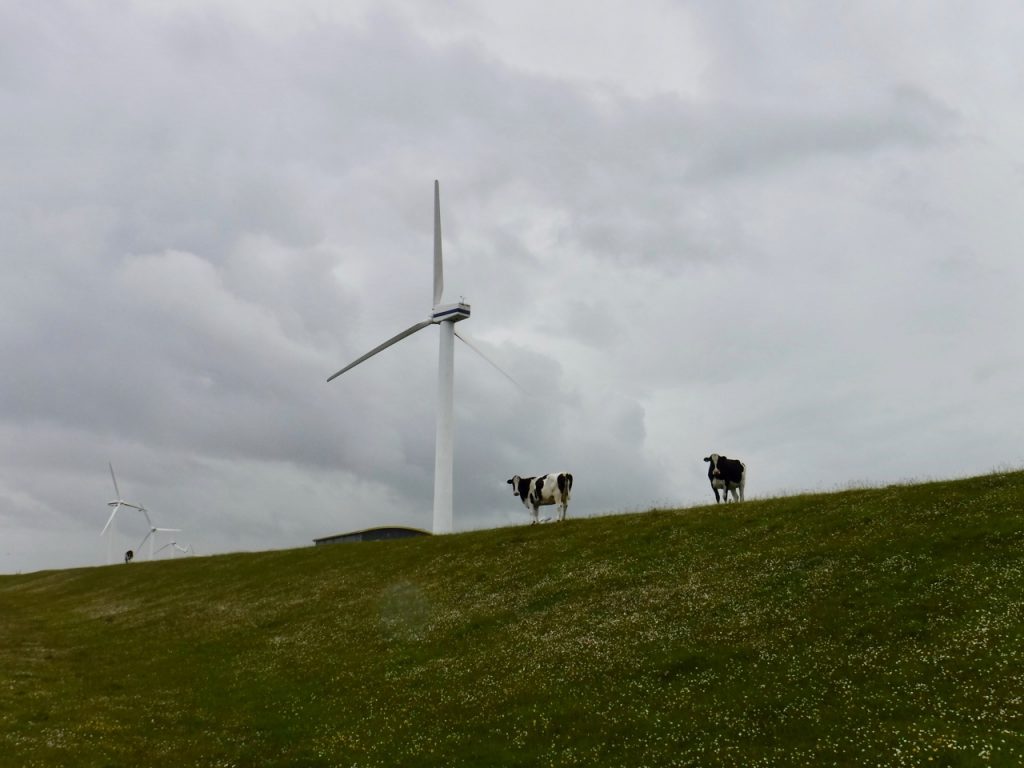
The path took us to a raised area I would call a levee. We climbed up and walked along it at first, but there being cows on it I took to the lower ground with Christy so as not to spook them. Audrey by now was raising concerns that we didn’t seem to be on a path anymore and soon we found our way barred by a fence. Beyond it was a field with sheep and cows, a line of five wind turbines and a couple of guys with a van admiring the nearest turbine. The fence was adorned with barbed wire and the gate tied with a Gordian knot.
We wondered if we should retrace our steps to the road, or perhaps climb the fence and head directly for the road. But I recalled that the ECR took a track through a wind farm so suggested we climb the fence and follow that track. I was of course mistaking these wind turbines for those we might have walked by had the route not been diverted earlier.
We climbed the gate, manhandled the squirming dog over, picked our way around a morass of mud and got onto the tubing service track. The sheep shuffled aside making room for us to pass. The cows though were a little more inquisitive, and we were followed by snorting cows. Farmgirl was unperturbed while I only affected disconcern and did not look behind me. Our escape to the A596 involved climbing another gate, not because it was locked but because neither of us could get the latch to slide open. Why did I not take WD40?
The next 40 minutes walking along the A596 was not especially pleasant. There was little to see besides the railway, lorries, cars, and rain. There were wild flowers including Red Valerian and Golden Melilot, but lunch was on my mind.. Flimby was very roughly half way and would have been a reasonable distance to pause for lunch. There was even a pie shop. But neither of us fancied eating by the road, and it was still raining. The bus stops didn’t have seats and neither did Flimby Railway station. I know this because Audrey went on a recce there. (So she actually walked further than me even though her GPS said otherwise).
There is a statue depicting a group of miners beside the road at what would once I imagine have been Risehow colliery. The artist was Colin Telfer, who had produced the statue of St Bega we saw in St Bees. Colin Telfer’s life is quite a story of change. He was born in Flimby and after school worked at the Risehow Colliery. As various collieries closed he moved to work at several others and eventually after a variety of jobs moved to Chapel Bank steelworks but that closed and he was made redundant at the age of 40. He was offered retraining and decided to attend Carlisle College of Arts. He had initially hoped to train in signwriting but there were no courses available so instead he chose to study fine arts. After completing his studies he became a sculptor, working until the age of 70 when his sight deteriorated. We were to see two more of his sculptures later in the day.
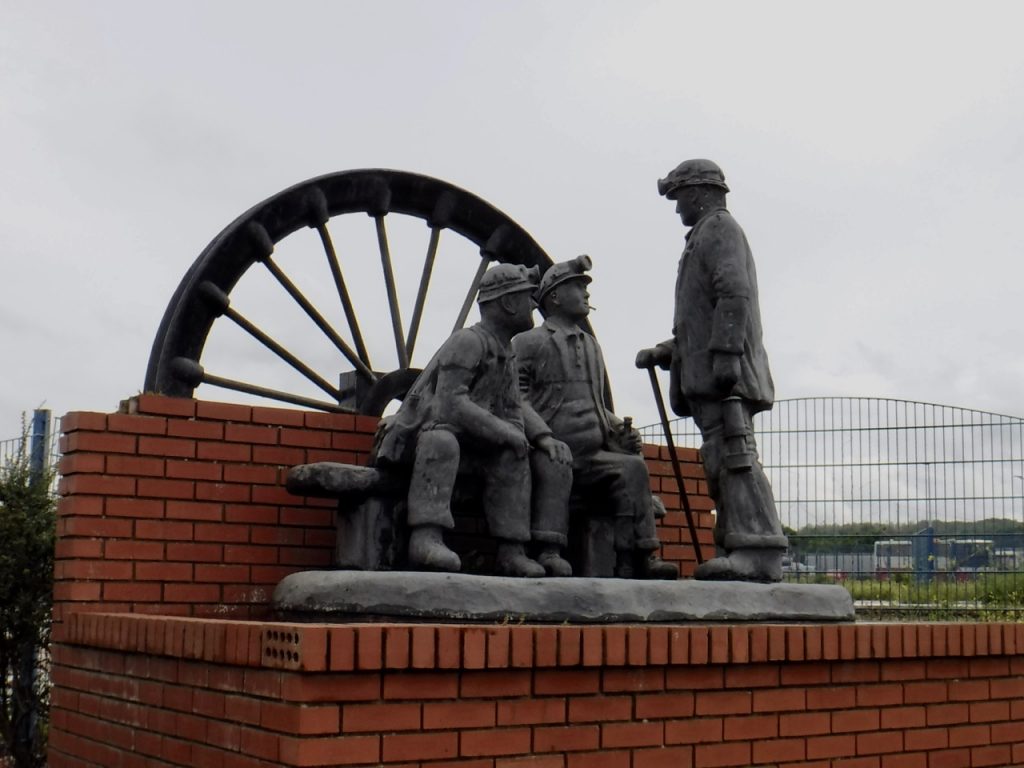
At Flimby Ambulance station our prayers were answered and the ECR left the main road for a coastal path. It was a relief to swap the hectic traffic for the more relaxing sound and smell of the sea. And I’m sure Christy was happier running free on the grass.
A curved wall standing in the middle of nowhere suggested the possibility of some shelter from the wind if not the rain, and there was even a seat dry enough to sit on. The wall did indeed offer shelter and the rain decided to have a break. A great place for lunch. I sat down with a bump having miscalculated the height of the bench which was about 3 inches lower than my brain chad estimated. My only injury was to my prid, though I thought I might have heard a chuckle from somewhere. We sat and ate while Christy played with his ball. Several other dog walkers passed by including one with a Labrador carrying the largest dog stick I have ever seen.

We were not far now from Maryport. Criffel was clearly visible beyond the gravel beach. A Stonechat (I think it was) sat oblivious of us in a bush beside the path. The wind turbines and smoking factories were now far behind. Ahead we could see the buildings around the marina at Maryport, many looking quite new but in a style reminiscent of eighteenth or nineteenth century harbour buildings.

Our walk around the harbour was a little longer than planned since the pedestrian bridge was raised and we had to walk all the way back to get around the water. A smell of fish hung in the air about the small fishing boats in the harbour, and a children’s play area with a pretend pirate ship stood just a stone’s throw from the coastguard office.
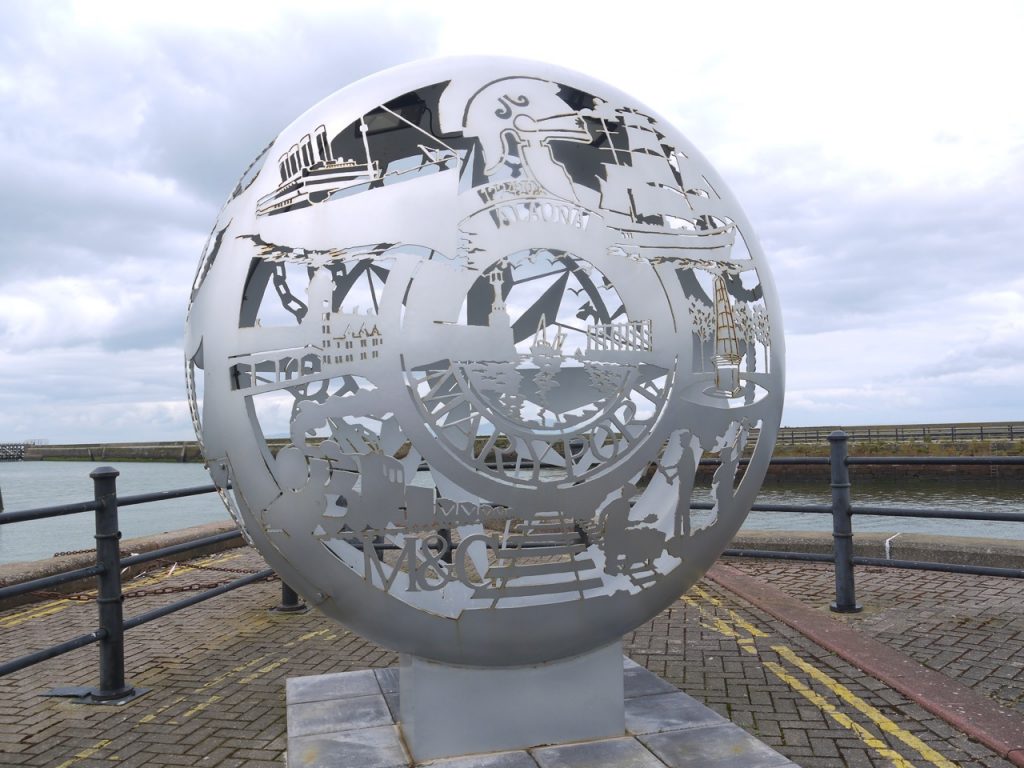
The Alauna Aura, a silver sphere sculpture stands by the water, a nearby plaque explaining its purpose and giving a potted history of the town.

I was interested to read that the town’s name comes from Mary Senhouse, the wife of the man who developed the harbour and that Lowry had painted the town.
The plaque also mentions Fletcher Christian, born locally, of HMS Bounty. A little further along the dockside is a memorial to another local boy, Edward Benn Smith DCM, VC. who earned the Victoria Cross, and his story.
At the bridge over the River Ellen is another of Colin Telfer’s sculptures, A Fishy Tale, depicting two men a boy and his dog chatting (see top of the post). We then went in search of the library on Senhouse Street and another of Telfer’s sculptures, this one a lamplighter.
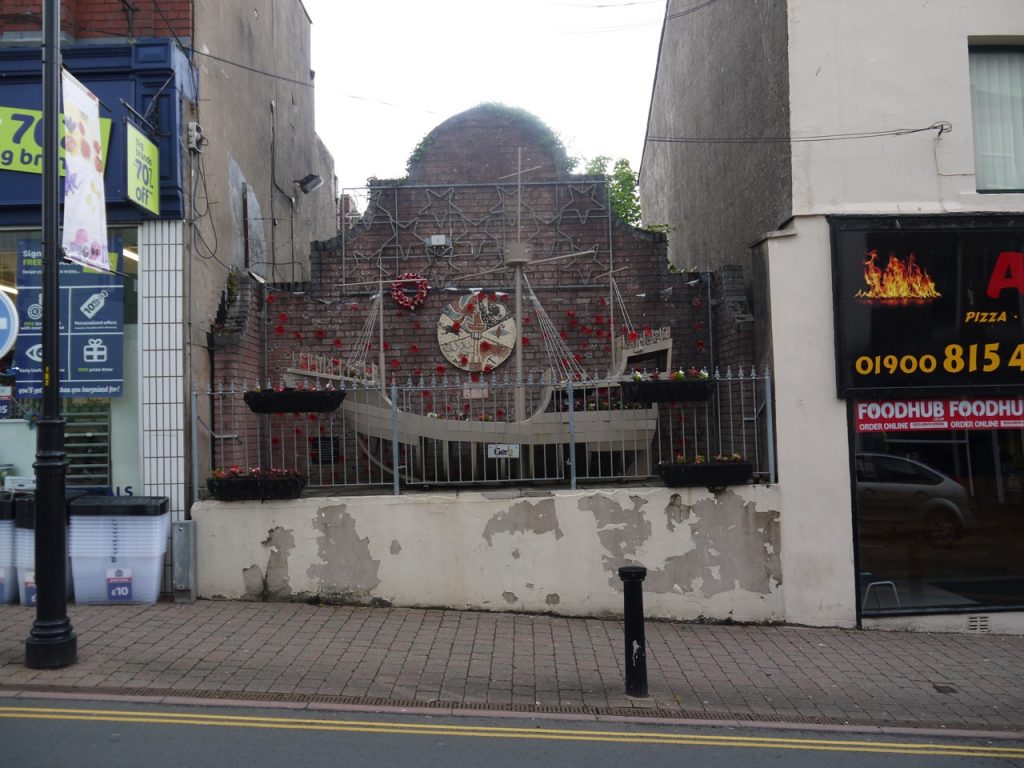
Maryport seemed a pretty place. Senhouse Street was in good nick with even the closed shops boarded up in a way that made them look nice.

We left the town walking past Christ Church which, rather unusually for a church, has a couple of cannons outside it along with a seat and another anchor.
Much of the remainder of the walk was along Maryport’s long promenade with excellent views of Criffel. I climbed the wall to have a look at the Millennium Green with its rocks, seats, half a boat and strange bars 6 inches high whose purpose escapes me.

By now we were growing tired and the last few minutes took us through the golf course. Several signs warned us to beware golf balls, but I would have thought you wouldn’t see the ones that were going to hit you. That was certainly our experience when we lived next door to a golf course.
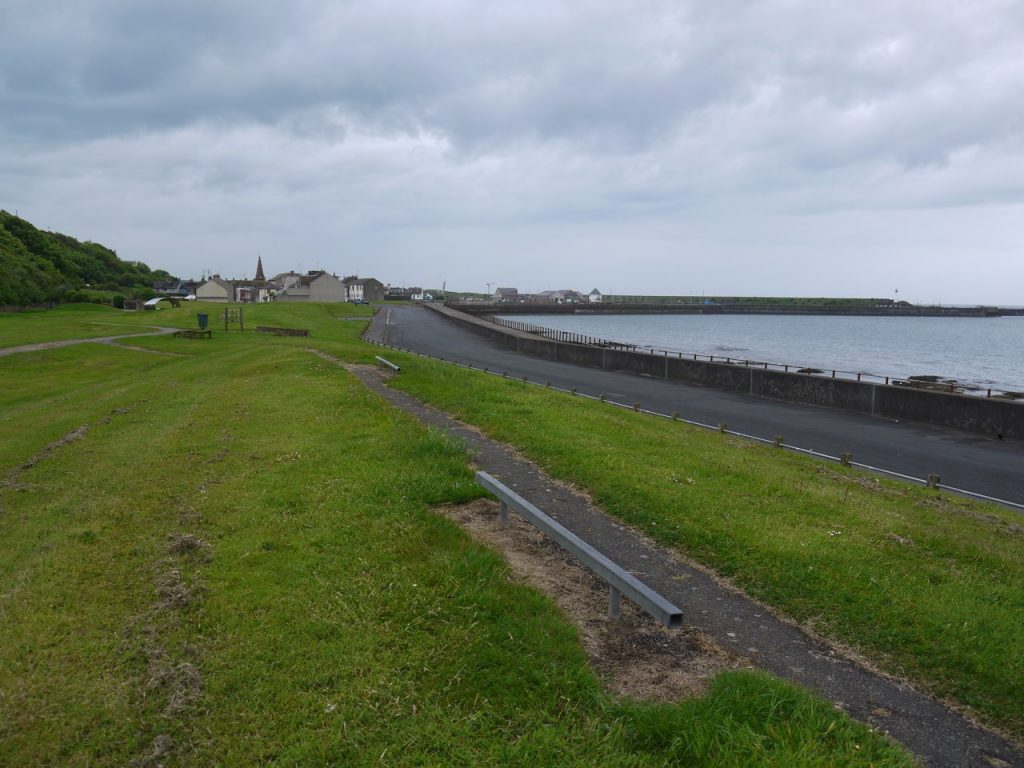
The last few hundred metres were on a roadside cycleway. The rain began to increase in intensity just as we glimpsed the car but the heavy rain held off until we were in the car.

